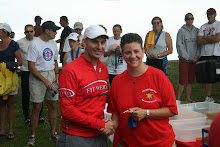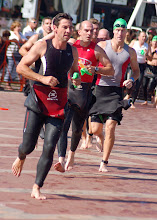Swim with the fishes usually means someone is dead, but not in this case. It's what I hope to do more efficiently as I prepare for IMLP. I've been working with Craig Lewin of the North Shore Swim Club and I'm excited share my initial evaluation with you. Lot's of work to be done, but I'm working with the right person. If the swim is an area of weakness and you want to improve Craig will get you there.
Marty Miserandino Stroke Evaluation by Craig Lewin - North Shore Swim Club - enduranceswim@gmail.com
Your stroke has come a long way since we started working together at the beginning of the summer. Your freestyle looks much better and you are starting to grasp the concepts needed for an efficient stroke. There are still some aspects of your stroke that need correcting to have an efficient stroke to help you fly through the swim using as little energy as possible. This efficiency will make your Ironman Lake Placid experience much more enjoyable because you will exit the water with a fast swim time and you will feel warmed up and ready to go for the bike. You will get on the bike feeling fresh and you will feel as though the swim was effortless. You will have the energy you need to put together solid bike and run legs to finish off the race.
The first major correction that needs to be made is in your hip rotation. As of now you still need some work rotating from one side to the next. The roll from the lower back up through the shoulders is good but the hips and legs remain flat. You need to get the hips to match the roll of the body. The body rolls as a unit, so think of the body as a log. A log cannot roll in segments, it rolls as one large unit and that is exactly how your body needs to roll as you go from one stroke to the next. This body roll is going to allow you to reduce your drag in the water so you will move faster and smoother in the water. The way we are going to go about correcting this problem is through the use of a couple of drills that focus on body position and balance in the water. We will start with fins until you get the hang of it and then from there we will drop the fins so that it will be closer to what the body position should feel like when swimming without any equipment. The use of the fins with these drills also helps to fix the dynamics of your kick and will actually make you a better kicker as well. The drills that we will be using to help correct these body roll issues are: head lead kick on stomach, head lead and hand lead sweet spot on the right and left side, Six Kicks and Roll, One Stroke Six Kicks, and the Kickboard drill. These drills are a progression that will teach where your balance point is in the water. Each drill will build on the one before it so that by the last drill you are swimming with better body rotation.
The second issue that needs correcting is in the recovery phase of your stroke. When you are entering the water, you are entering thumb first with your knuckles facing in and you are entering too shallow. The most efficient stroke is when your knuckles are aiming in the direction that you are swimming in. You also want to aim for the bottom of the T at the other end of the pool as you enter because this will ensure that your hand enters at the proper depth. This deep entry will eliminate the possibility of a shoulder press in the stroke. We want to avoid the shoulder press in the stroke when entering the water too shallow for two main reasons. The first is that having this shoulder press will lead to some major pinching in the shoulder and will result in a very serious shoulder injury. The second reason is that this motion only lifts your body up it does not move it forward. Everything in swimming is linear so any motion that is not a forward/backward motion is inefficient and a waste of energy. As your hand exits the water at your hip, you want to lift your elbow to the ceiling and drop your forearm so your hand is within a couple inches of your torso. This relaxing of the forearm and hand will naturally cause your knuckles to face the end of the pool that you are swimming toward. Once your hand is just beyond your head and inline with your shoulder you want to drive your finger tips down eight to ten inches deep. As you do this you are rolling into the stroke so that you get full arm extension and can catch more water during your catch phase. The drills that we will use to correct this problem of entering thumbs first and too shallow are: shark fin drill on your left and right side, stop-stop-switch drill, double entry drill, and catch-up drill. These drills will help get your arm in the proper position when starting the recovery. They will help keep the hand close to your side with your knuckles facing the proper direction. They will allow you to focus on entering deep and fully extending as you roll into the stroke making for a very fast and efficient stream line stroke.
The third issue that needs correction is your catch phase. Currently you drop your elbow and do not catch much water on the pull through. After your hand enters the water finger tips first and goes eight to ten inches deep, you want to fully extend your arm out as you continue to roll on your side. Once you are ready to pull you need to press down slightly with the finger tips and forearm. As you do this slight press you pop your elbow up. This will anchor in your arm and allow you to actually grab the water. Once you have popped the elbow up you want to pull through. Getting your elbow up and pressing your hand shifts the muscle group being used to pull from your shoulder to primarily your lats which is exactly what you want to do. Your shoulder muscles are not made for the constant contraction experienced when swimming. Your lats are much bigger muscles and they can handle this constant contraction and relaxation. Not only can they handle this but your lats can produce more power so that you can actually move faster with every pull, which is essentially the goal of swimming. This is why it is so important to get the elbow up when you start your pull and to keep it up throughout the pull. When you pull, you want to move your arm through the water as a unit once you have pressed your hand and forearm down and popped the elbow up. Your elbow should always be higher than your wrist during the pull phase of the stroke. Then as you pull you are rolling from one side into the next stroke on the other side. This pressing with the hand and forearm and popping the elbow up is what is missing in your stroke. To fix this problem area the drills that we will be using are: Hand lead sweet spot focusing on keeping the arm in line with the shoulder, Press-Release drill on each side, Press-Release-Press-Pull drill, One Arm Swimming, Catch-Up stroke, and Semi-Catch-Up stroke. These drills will help slow down your stroke enough so that you can focus on the slight press of the hand and forearm and the popping up of the elbow. You should be able feel the contraction in your lats as you do the slight press and continue to feel it as you pull the arm through until your hands exit at your hips.
The plan for the rest of the fall is to correct your technique while maintaining your fitness level as well as some speed. I want to really focus on making these corrections now and really reinforcing them before we hit base phase come January. This way you will have a proper stroke and you will not even have to think about what you are doing anymore. You will be able to really focus on the purpose of the sets rather than both the purpose of the sets and correcting technique. Once you get to that point we will really be able to get some big yards and fast swims in without having to worry too much about any shoulder injuries. You just have to remember that fixing these technique flaws is easy speed. Becoming more efficient makes you faster with less effort and that is why the speed comes easy. Combining this technical approach to swimming with some speed and distance workouts is going to lead to big drops in time come the 2010 triathlon season. This is not an easy process but it is essential in the sport of triathlon when the swim is only the beginning of your race. Swimming fast while saving energy in the swim through proper technique is what will lead to a successful day out on the race course. By the time the triathlon season comes around you will be swimming fast and efficiently and the 2.4 mile swim at Lake Placid will be the easiest part of your day!
Up next: The bike
skip to main |
skip to sidebar

2nd in my age group

Witch City


HOME | FITTING SERVICES | ONLINE STORE | TECH CENTER | OUR ATHLETES | ABOUT US | NEWS & EVENTS | CONTACT US | SITE MAP
On Sunday, July 26th, 2009 my brother Vince and I traveled to Lake Placid to volunteer for the Ironman. On Monday, July 27th we tossed our hats into the ring and signed up for IMLP 2010. This is my story...
Blog Archive
Witch City Tri - 8/2/09

2nd in my age group
On the Run

Witch City
In transition
Looking for a great coach? Your Goals, his knowledge, Unstoppable!
North Shore Swim Club - Craig Lewin will make you a better swimmer and faster.
Body Tuning Physical Therapy - Sara Thatcher will get you ready to work out and compete in top form
Parlee Cycles
B&S Fitness - PsychoFitt & More
Kilroy Chiropractic - They keep me in line!
The Zone Lifestyle - Train and Race Harder, Recover Quicker






No comments:
Post a Comment